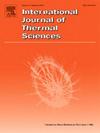Similarity analysis for reorientation and self-pressurization of cryogenic fluids in on-orbit propellant tanks
IF 4.9
2区 工程技术
Q1 ENGINEERING, MECHANICAL
International Journal of Thermal Sciences
Pub Date : 2025-04-14
DOI:10.1016/j.ijthermalsci.2025.109910
引用次数: 0
Abstract
Cryogenic propellants are identified as one of the most promising technologies due to their advantages in specific impulses. However, there still exist gaps in the available knowledge of microgravity cryogenic fluid management, particularly on a large scale. In this study, scaling laws for the interface reorientation and self-pressurization conditions are proposed and validated. Accurate scaling for stationary self-pressurization conditions was achieved by adopting and as similarity criteria. For interface reorientation conditions, the pressure is influenced mainly by the rapid condensation on the interface. The time-factor is proposed to decouple the evolution of the interface and the characteristic length. A new scaling law, , is proposed to improve the interface similarity between the subscale and the prototype models. The new scaling law significantly improved the pressure prediction accuracy in the scaled models, with a maximum pressure deviation of less than 5%. The scaling methods for the on-orbit cryogenic propellant fluids were systematically proposed and examined by drop tower and ground-based experiments. The results provide a theoretical basis for further scaling experimental and numerical studies of on-orbit cryogenic storage.
在轨推进剂储罐低温流体定向和自加压的相似性分析
低温推进剂由于其在特定脉冲方面的优势而被认为是最有前途的技术之一。然而,在现有的微重力低温流体管理知识方面,特别是在大规模的微重力低温流体管理方面,仍然存在空白。在本研究中,提出并验证了界面重定向和自加压条件下的标度规律。采用Fo和Bo作为相似准则,实现了平稳自增压条件的精确标度。在界面重定向条件下,压力主要受界面上快速凝结的影响。提出了时间因子来解耦界面的演化和特征长度。提出了一个新的尺度定律t ~ L1.65,以提高子尺度和原型模型之间的界面相似性。新的标度律显著提高了标度模型的压力预测精度,最大压力偏差小于5%。系统地提出了在轨低温推进剂液体的标度方法,并通过落塔试验和地面试验进行了验证。研究结果为进一步开展在轨低温存储的规模化实验和数值研究提供了理论依据。
本文章由计算机程序翻译,如有差异,请以英文原文为准。
求助全文
约1分钟内获得全文
求助全文
来源期刊

International Journal of Thermal Sciences
工程技术-工程:机械
CiteScore
8.10
自引率
11.10%
发文量
531
审稿时长
55 days
期刊介绍:
The International Journal of Thermal Sciences is a journal devoted to the publication of fundamental studies on the physics of transfer processes in general, with an emphasis on thermal aspects and also applied research on various processes, energy systems and the environment. Articles are published in English and French, and are subject to peer review.
The fundamental subjects considered within the scope of the journal are:
* Heat and relevant mass transfer at all scales (nano, micro and macro) and in all types of material (heterogeneous, composites, biological,...) and fluid flow
* Forced, natural or mixed convection in reactive or non-reactive media
* Single or multi–phase fluid flow with or without phase change
* Near–and far–field radiative heat transfer
* Combined modes of heat transfer in complex systems (for example, plasmas, biological, geological,...)
* Multiscale modelling
The applied research topics include:
* Heat exchangers, heat pipes, cooling processes
* Transport phenomena taking place in industrial processes (chemical, food and agricultural, metallurgical, space and aeronautical, automobile industries)
* Nano–and micro–technology for energy, space, biosystems and devices
* Heat transport analysis in advanced systems
* Impact of energy–related processes on environment, and emerging energy systems
The study of thermophysical properties of materials and fluids, thermal measurement techniques, inverse methods, and the developments of experimental methods are within the scope of the International Journal of Thermal Sciences which also covers the modelling, and numerical methods applied to thermal transfer.
 求助内容:
求助内容: 应助结果提醒方式:
应助结果提醒方式:


